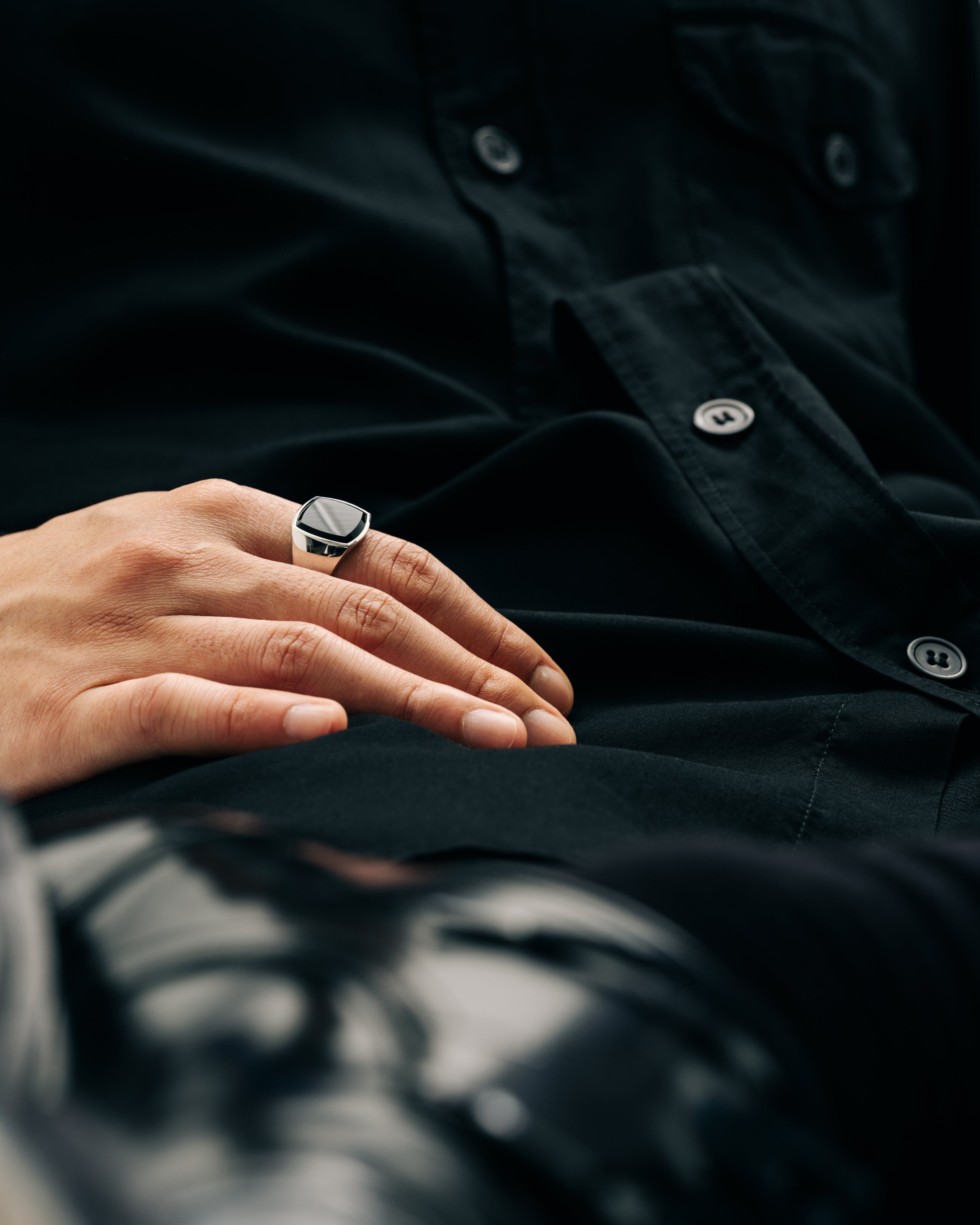Silver jewellery has a timeless appeal. Whether it’s a delicate chain, a bold statement ring, or a pair of everyday earrings, silver pieces add effortless elegance to any look. But like all precious metals, silver requires a little extra care to keep its shine. Over time, you may notice your jewellery beginning to dull or develop dark patches — a natural process known as tarnishing.
The good news? Tarnish isn’t permanent, and your jewellery isn’t damaged. With the right cleaning and storage habits, you can restore the sparkle and prevent dullness from setting in too quickly.

This guide will walk you through everything you need to know about caring for silver jewellery. From understanding why silver tarnishes, to learning the best at-home cleaning methods, to exploring how to store rings, bracelets, necklaces, and earrings, you’ll find practical tips to keep every piece looking its best.
With just a few simple habits, your silver jewellery can remain radiant for years. Taking their place as a lasting part of your personal collection.
Why Silver Jewellery Needs Care
Most silver jewellery is made from sterling silver, a blend of 92.5% pure silver and 7.5% other metals, usually copper. This alloy makes jewellery durable enough for everyday wear while keeping its beautiful sheen. But it also makes silver more reactive to the environment.
When silver comes into contact with sulfur, oxygen, or even moisture in the air, it begins to form a thin, dark layer on the surface. This process is called tarnishing, and it’s the reason silver pieces can lose their brightness over time.

The good news is that tarnish affects only the surface of the jewellery. It doesn’t mean your piece is ruined. With regular cleaning, careful storage, and mindful wearing, you can easily prevent tarnish from building up and keep your silver jewellery looking as stunning as the day you bought it.
General Rules for Silver Jewellery Care
Silver is a beautiful but relatively soft metal, which means how you wear and store it has a big impact on its longevity. Following a few simple rules will help preserve your jewellery’s shine and prevent unnecessary tarnish or scratches:
Avoid chemicals. Perfume, hairspray, lotions, and household cleaning products all speed up tarnishing. Make jewellery the last thing you put on when getting ready.
Remove before swimming, showering, or exercising. Chlorine, salt water, and sweat can all react with silver, leaving it dull or discoloured.
Wipe after wear. A quick polish with a soft, dry cloth removes oils and moisture, preventing tarnish from forming.
Store carefully. Keep silver pieces in airtight pouches, anti-tarnish cloths, or lined jewellery boxes. Always store items separately to avoid scratches and tangles.
Rotate your pieces. Wearing the same ring or bracelet every day exposes it to more wear. Rotating jewellery helps each piece last longer.
Wear it often. Surprisingly, silver jewellery tarnishes less when worn regularly. Natural oils in your skin act as a gentle polish, helping maintain its shine.
By incorporating these habits into your daily routine, you’ll dramatically slow tarnishing, prevent the risk of scratches developing and reduce the need for deep cleaning.
Cleaning Silver Jewellery at Home
Silver jewellery doesn’t require expensive products to stay radiant. The gentlest methods are often the most effective. With a few household items and the right approach, you can keep your pieces looking fresh without damaging them.
1. Soap and Water
The simplest and safest way to clean silver jewellery is with mild soap and warm water. Mix a few drops of dish soap in a bowl of lukewarm water, dip in a soft cloth or sponge, and gently wipe your jewellery. Rinse thoroughly in clean water and dry with a lint-free cloth. This method works well for regular upkeep.
2. Baking Soda Paste
For heavier tarnish, make a paste using two parts baking soda and one part water. Apply it gently to your jewellery with a soft cloth, rubbing in small back-and-forth motions. Rinse thoroughly and dry. This method is best for plain silver pieces without gemstones, as it may loosen delicate settings.
Disclaimer: This method is for cases where tarnishing is already heavily present, and should be seen as a last resort option.
3. Silver Polishing Cloth
A polishing cloth is one of the most effective tools for removing tarnish and restoring shine. These cloths are treated with special compounds that clean silver without harsh chemicals. Use gentle, straight motions rather than circular rubbing to avoid leaving fine scratches.

What to Avoid
Never use toothpaste, abrasive scrubs, or chemical dips on silver jewellery. They can scratch or damage finishes. Also avoid leaving silver wet after cleaning, as moisture accelerates tarnishing.
For most pieces, a quick wipe after each wear and a more thorough clean every month or two will keep them in excellent condition. With regular care, silver jewellery maintains its glow without the need for professional intervention.
Piece-Specific Silver Jewellery Care
Different types of silver jewellery face different types of wear. Here’s how to care for rings, bracelets, necklaces, and earrings so each piece stays in top condition.
Rings
Rings are exposed to the most daily wear since our hands are constantly in use. Soap and lotions can leave them looking dull. To care for silver rings:
Remove before washing hands, applying hand cream, or doing housework.
Clean weekly with soap and warm water to prevent buildup.
For detailed designs or engravings, use a soft toothbrush to gently clean crevices.
Bracelets
Bracelets rub against clothing and surfaces throughout the day, which can result in a development of scratches and tarnish. To protect them:
Wipe with a soft cloth after each wear to remove sweat and skin oils.
Store bracelets flat and unclasped to avoid bending delicate links.
Give them a deeper clean every month using mild soap and water.
Necklaces
Necklaces can tarnish quickly because they sit against the skin, absorbing oils and sweat. Chains are also prone to tangling and kinking if not stored properly. To keep them in excellent condition:
Remove necklaces before exercising or showering to prevent sweat and humidity damage.
After wearing, gently wipe the chain and pendant with a soft, dry cloth to remove skin oils.
Clean occasionally with mild soap and warm water, using a soft toothbrush for delicate links or textured pendants.
Always store necklaces clasped to prevent tangling, either laid flat in a lined box or hanging individually.
When travelling, use a roll-up jewellery pouch or thread the chain through a straw to stop it knotting.
Earrings
Earrings need extra attention because they come into close contact with skin and hair products. They also have the added concern of hygiene, especially for pierced ears. To care for silver earrings:
Wipe earrings with a soft polishing cloth after each wear to remove oils and residue.
Clean posts and backs regularly with a little rubbing alcohol on a cotton pad to maintain hygiene.
Avoid putting on earrings before using hairspray, perfume, or face creams, as these products can dull silver.
Deep clean monthly with mild soap and warm water, making sure to dry thoroughly before storing.
Storage & Long-Term Maintenance
How you store silver jewellery makes a big difference to how well it resists tarnish and scratches. Even if you clean your pieces regularly, poor storage can undo your hard work.
Choose airtight storage. Keep silver in sealed pouches, anti-tarnish bags, or lined jewellery boxes to limit contact with air and humidity.
Store pieces separately. Silver scratches easily, so rings, bracelets, necklaces, and earrings should each have their own compartment, pouch, or soft cloth wrap.
Keep moisture away. Add silica gel packs or anti-tarnish strips to your storage area to absorb humidity. Never store silver in the bathroom.
Prevent tangling. Hang necklaces individually or clasp them and lay flat in anti-tangle organisers. For travel, use a roll-up jewellery pouch or thread chains through straws to keep them knot-free.
Consider professional care. For heirlooms or heavily tarnished pieces, a jeweller can deep clean, polish, and inspect for loose stones or weak clasps.

By storing your silver properly and checking it regularly, you’ll not only keep it looking beautiful but also extend the life of each piece for years to come.
Shining for Years to Come
Silver jewellery is meant to be worn, enjoyed, and cherished — not hidden away because of tarnish or dullness. With just a few mindful habits, like cleaning gently, storing carefully, and wearing pieces often, you can preserve the brilliance of your silver for years to come.
By cleaning gently, storing thoughtfully, and wearing your pieces with love, you ensure that each ring, bracelet, necklace, or pair of earrings keeps its beauty for years to come. Tarnish and dullness are temporary, but care creates permanence.
When silver is looked after, it remains more than jewellery. It becomes a companion to your everyday life and your special milestones. This guide will ensure that your pieces are always ready to shine, and always ready to tell your story.

Prevent Tarnish with Smart Habits
Avoid chemicals, remove jewellery before water or sweat exposure, and store pieces in airtight pouches or lined boxes.
Clean Gently and Regularly
Use mild soap and water, baking soda paste, or a polishing cloth. Never harsh chemicals or abrasives. A quick wipe after each wear makes a big difference.
Tailor Care to Each Piece
Rings, bracelets, necklaces, and earrings all face different kinds of wear. Adjust your cleaning and storage routine accordingly to keep every piece looking its best.




